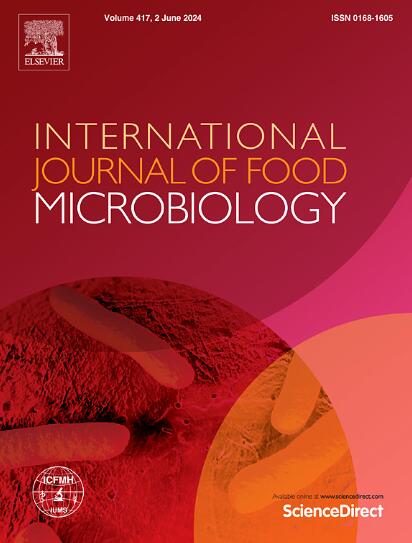Companilactobacillus crustorum LMG 23699 and Wickerhamomyces anomalus IMDO 010110 form a candidate, stable, mixed-strain starter culture for sourdough production
IF 5.2
1区 农林科学
Q1 FOOD SCIENCE & TECHNOLOGY
International journal of food microbiology
Pub Date : 2025-05-20
DOI:10.1016/j.ijfoodmicro.2025.111278
引用次数: 0
Abstract
Companilactobacillus crustorum LMG 23699 is a candidate starter culture for sourdough production. White wheat and wholemeal wheat Type 3 sourdough productions started with this strain showed its competitiveness and robustness. Moreover, starter culture strain monitoring by an amplicon sequence variant approach revealed its prevalence, and unraveled a consortium with the yeast Wickerhamomyces anomalus. Even a temperature perturbation during sourdough storage, which caused an increase in the relative abundance of the background Levilactobacillus parabrevis, could not eliminate this starter culture strain. In addition, Coml. crustorum LMG 23699 always prevailed during wholemeal wheat Type 2 sourdough productions started with different ratios of this strain and Levl. parabrevis IMDO 033007 (isolated from the above-mentioned sourdoughs), with and without W. anomalus IMDO 010110 (isolated from the above-mentioned sourdoughs). When the yeast strain was co-inoculated, the four main flour carbohydrates and mannose were depleted and more D-lactic acid was produced, pointing toward a stable interaction between Coml. crustorum LMG 23699 and W. anomalus IMDO 010110. To conclude, the present study showed that the competitive and robust Coml. crustorum LMG 23699 could form with W. anomalus IMDO 010110 a new, stable, microbial consortium for sourdough productions.
壳状芽胞杆菌LMG 23699和异常Wickerhamomyces IMDO 010110是一种稳定的混合菌种酵母发酵剂
壳状芽胞杆菌LMG 23699是酵母生产的候选发酵剂。用该菌种生产的白小麦和全麦3型酵母具有很强的竞争力和稳健性。此外,通过扩增子序列变异方法对发酵剂培养菌株进行监测,揭示了其流行情况,并揭示了与Wickerhamomyces anomalus酵母的联系菌。即使在酵母储存过程中温度的扰动导致背景副乳杆菌相对丰度的增加,也不能消除这种发酵剂菌株。此外,Coml。在不同菌种比例和水平下,lmg23699型酵母在全麦2型酵母生产中占优势。parabrevis IMDO 033007(从上述酵母中分离),含和不含W. anomalus IMDO 010110(从上述酵母中分离)。当酵母菌株共接种时,四种主要的面粉碳水化合物和甘露糖被消耗,d -乳酸的产生更多,表明Coml和Coml之间存在稳定的相互作用。lmg23699和imdo010110异常w。综上所述,本研究表明,竞争和稳健的Coml。LMG 23699可以与反常W. IMDO 010110形成一个新的、稳定的酵母生产微生物联合体。
本文章由计算机程序翻译,如有差异,请以英文原文为准。
求助全文
约1分钟内获得全文
求助全文
来源期刊
CiteScore
10.40
自引率
5.60%
发文量
322
审稿时长
65 days
期刊介绍:
The International Journal of Food Microbiology publishes papers dealing with all aspects of food microbiology. Articles must present information that is novel, has high impact and interest, and is of high scientific quality. They should provide scientific or technological advancement in the specific field of interest of the journal and enhance its strong international reputation. Preliminary or confirmatory results as well as contributions not strictly related to food microbiology will not be considered for publication.

 求助内容:
求助内容: 应助结果提醒方式:
应助结果提醒方式:


